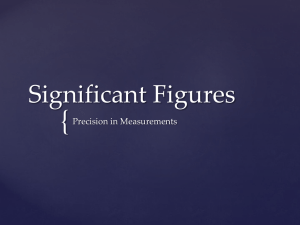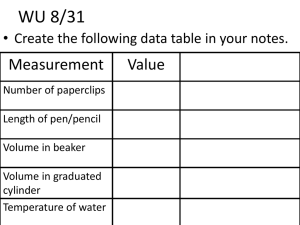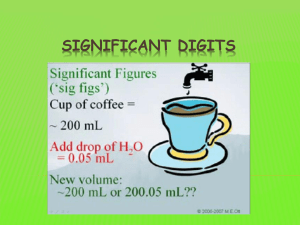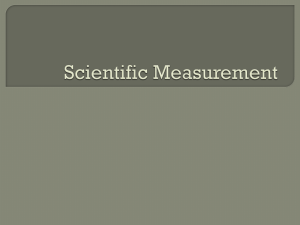Significant digits
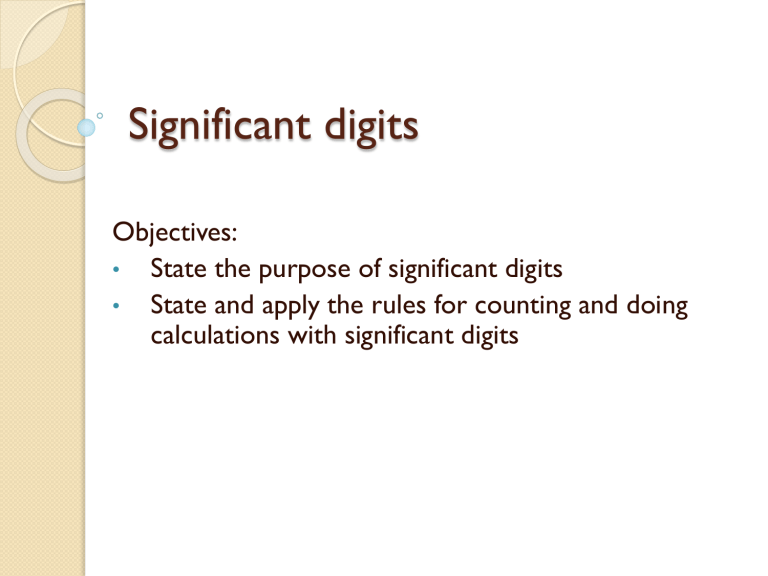
Significant digits
•
•
Objectives:
State the purpose of significant digits
State and apply the rules for counting and doing calculations with significant digits
One way engineers use significant digits….
Significant digits
Measurements that indicate the precision of the tool used
Important—we want to let other scientists and engineers know how
“good” our measurements are!
3.42 cm
This means:
◦ My tool had markings to the tenths place (I can
COUNT them)
◦ I estimated the hundredths place (the object was between 3.4 and 3.5 but closer to 3.4)
◦ 3 significant digits
3900 cm
This means:
◦ My tool had markings to the thousands place
(I could COUNT them)
◦ I estimated the hundreds place (the object was between 3000 and 4000 but much closer to 4000 )
◦ 2 significant digits
3900. cm
This means:
◦ My tool had markings to the tens place (I could COUNT them)
◦ I estimated the ones place (the object appeared to be right at 3900)
◦ 4 significant digits
Clues: How to know when a number is significant
It is a non-zero ( 1, 2, 3, 4, 5, 6, 7, 8, 9 )
It is a zero at the END of a decimal
AFTER a decimal point (4.5
00 )
It is a zero between non-zeros (5, 00 5)
It is a zero at the end of a whole number
AND there is a decimal (5 0 .)
Examples of Sig zeros
Examples of NONsig zeros
5, 00 2
56 00 .
.3
0
0.00
5
0.0
3
3 0
5 0,000,000
This number has a mix of significant and insignificant zeros:
0.00
3 00
Rules for counting significant digits:
2300
23 00 Non-zeros are significant
23 00 zeros are at the end of a number without a decimal = insignificant
23 00 = 2 s.f.
This means the tool allowed us to
COUNT the thousands place, and
estimate the hundreds place (we counted to 2000 and we estimated the value was between 2000 and 3000, but closer to
2000.)
Counting significant digits:
230.
23 0.
Non-zeros = significant
230.
zero here is at the end of a number WITH a decimal = significant
230. = 3 s.f
This means the tool allowed us to
COUNT to the ones place 230 and we estimated that the value was exactly at
230.
Counting significant digits:
2.300 x 10 -3
BIG IDEA: count the digits of the coefficient only
2 .
3 00 x 10 -3 Non-zeros = significant
2.300
x10 -3 zeros here are at the end of a number and AFTER a decimal = significant
2.300 x 10 -3 = 4 s.f.
This means the tool allowed us to measure
.00230, and we estimated it was exactly at
.002300
Counting significant digits - Practice
0.00400
0.00
4 00 Non-zeros = significant !
0.
00 400 zeros here are at the beginning of a number = insignificant
0.004
00 zeros here are at the end of a number and AFTER a decimal = significant
0.00
400 = 3 s.f.
This means the tool allowed us to measure
0.0040, and we estimated it was exactly at
0.00400.
Practice
Problems 1-10 on your notes
Compare numbers – which is more precise and how do you know. Game – cc. add this to prac probs
Give practical example – ie 2 diff thermoms to meas the same temp
Practice - Answers
State the number of significant digits.
1) 1234 4
2) 0.023 2
3) 890 2
4) 91010 4
5) 9010.0 5
6) 1090.0010 8
7) 0.00120 3
8) 3.4 x 10 4 2
9) 9.0 x 10 -3 2
10) 9.010 x 10 -2 4
Calculations:
Addition and subtraction: USE lowest number of decimal places as the # of decimal places for your answer. Just do add probs in class maybe 1 subt. Prep to not have add and subt, and have it just in case
Another day multiplying and dividing USE least number of total sig figs as the # of sig figs for your answer.
Example:
350.83 kg +
400.0 kg
350.83 2decimal places
400.0 1 decimal place
750.83 kg
Lowest # of decimal places
= 1
I need to round this to only one decimal place
750.8 kg
Example:
2.0 x 8000 2.0 2 significant figures
8000 1 significant figure
16,000
LEAST? = 1
I need to round this to only one significant digit1
20,000
Practice
Problems 11-20 in your notes
Practice - Answers
5.33 + 6.020 = 11.350 11.35
5.0 x 8 = 40.0 40
81÷ 9.0 = 9.0 9.0
3.456 – 2.455= 1.001
1.001
5.5 – 2.500 =3.000 3.0
7.0 x 200 =1400.0 1000
300. ÷ 10.0 = 3.0 3
(3.0 x 10 4 )x (2.0 x 10 1 ) = 6.0 x 10 5 6.0 x 10 5
(9.000 x 10 -2 )÷ (3.00 x 10 1 ) = 3.000 x 10 -3 3.00 x 10 -3
(3.0 x 10 4 ) - (2.0 x 10 1 ) = 2.998 x 10 4 3.0 x
10 4
Exit Ticket
2300
Counting significant digits:
450.0
◦ What do we know about the measurement made?
◦ How many significant digits are in the answer?
◦ Is this number more less precise than the previous answer?
Counting significant digits:
20
◦ What do we know about the measurement made?
◦ How many significant digits are in the answer?
◦ Is this number more less precise than the previous answer?
Counting significant digits:
0.000450
◦ What do we know about the measurement made?
◦ How many significant digits are in the answer?
◦ Is this number more less precise than the previous answer?
Counting significant digits:
3,006
◦ What do we know about the measurement made?
◦ How many significant digits are in the answer?
◦ Is this number more less precise than the previous answer?
Counting significant digits:
23.00
23 .00 Non-zeros = significant !
23.00
zeros here are at the end of a number and AFTER a decimal = significant
23.00 = 4 s.f.
This means the tool allowed us to measure 23.0, and we estimated it was exactly at 23.0.
Example:
10.75 – 0.411
10.75 2 decimal places
0.411
3 decimal places
10.339
LEAST? = 2
I need to round this to only two decimal place!
10.34





